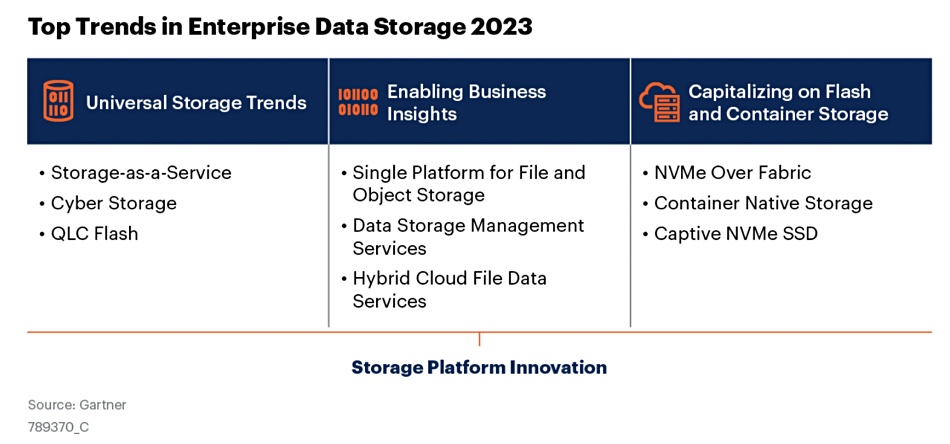Gartner reckons the top enterprise storage trends for 2023 include cloud operating models, new SSD technologies, cyber security against ransomware, and better use of unstructured data for analytical insights.
We get to see its document thanks to cyber storage and protection supplier RackTop Systems, which has made it available.
The Gartner analysts start with a set of strategic planning assumptions, and then lay out the nine top trends in three categories:

None of these topics will be news to B&F readers. Each trend is anchored by a strategic planning assumption (SPA), such as “By 2028, consumption-based STaaS will replace over 35 percent of enterprise storage capex, up from less than 10 percent in 2023.”
Gartner then renames the three headings from left to right to be Common, Unstructured Data Storage, and Block Storage, and have an analyst discuss each of the nine trend topics.
Storage-as-a-Service – Managed STaaS is powered by storage vendor’s software and/or appliances, which bring the enterprise feature set, availability, and performance, while delivering a cloud-like consumption model.
Cyber storage – By 2028, 100 percent of storage products will include cyber storage capabilities focused on active defense beyond recovery from cyber events, from 10 percent in early 2023. Most major storage vendors are actively working on cyber storage capabilities, which might be included with storage systems or enabled as a separate product. Innovative startups are releasing products supporting heterogeneous capabilities to protect enterprise data for block, file, and object storage.
QLC flash – By 2027, enterprises will use QLC in 25 percent of their SSD flash media, up from five percent in late 2022. The cost delta advantages of QLC versus triple-level cell (TLC)-based arrays, coupled with enhanced durability and performance, provide enterprises with sufficient long-term benefits (e.g. the rapid restoration of backup data in the event of a ransomware event recovery).
Single file and object storage platform – By 2028, 70 percent of file and object data will be deployed on a consolidated unstructured data storage platform, up from 35 percent in early 2023. A single platform for file and object data enables consolidation of all unstructured data workloads, which not only simplifies storage operations but also storage sourcing activities.
Data storage management services – By 2027, at least 40 percent of organizations will deploy data storage management solutions for classification, insights, and optimization, up from 15 percent in early 2023.
Hybrid cloud file data services – By 2027, 60 percent of infrastructure and operations leaders will implement hybrid cloud file deployments, up from 20 percent in early 2023. This will consolidate unstructured data to a single copy, enabling centralized management around the protection and security of the underlying data, thereby simplifying operations while consolidating use cases. Typical outcomes include cost optimization to align the cost of the storage with the value of the data; data governance to ensure sensitive data has the right protection and retention policies applied; data security to enable the right level of permission and access level controls; and enhanced analytics workflows that leverage data classification and optional tag the data with custom metadata.
NVMe over Fabric – By 2027, 25 percent of enterprise organizations will deploy NVMe-oF as a storage network protocol, up from less than 10 percent in mid-2023. Of the NVMe-oF options, NVMe-TCP has the most to gain as on-premises where Ethernet costs and simplicity can rival both iSCSI and low-end Fibre Channel SAN bandwidth requirements at or below 16Gbit/sec. Further, NVMe-oF can scale out to high capacity levels with high-availability features and be managed from a central location, serving dozens of compute clients.
Container-native storage – By 2027, 80 percent of Kubernetes deployments will require advanced features for persistent containers storage compared to 30 percent in early 2023. While containers are built to be stateless, the volume of deployments requiring persistent data for stateful applications is increasing. A good starting point for an initial Kubernetes deployment is traditional storage approaches, where Container Storage Interface (CSI) is abstracting the underlying storage platform.
Captive NVMe SSD – “Captive” being Gartner’s way of describing computational storage SSDs doing onboard compression etc. By 2026, captive NVMe SSDs will replace over 30 percent of deployed on-premises capacity, up from less than five percent mid-2023. Use of captive NVMe SSD drives provide myriad favorable benefits ranging from enhanced storage operations and cost savings to a more resilient and intelligent data storage services environment.
Gartner says: “The challenges arise from managing the explosive growth of enterprise data, the business need for an on-premises cloud-like consumption model to mitigate cyber attack risks, or leveraging latest storage technologies like QLC or NVMe over fabric for better cost and/or performance.”
IT leaders can, it asserts, proactively respond to business demands by using these technology trends to build flexible and agile storage platforms.
B&F thinks fast technology followers will be doing this already. Gartner’s doc reassures the slower and less certain that they should be doing it too.








